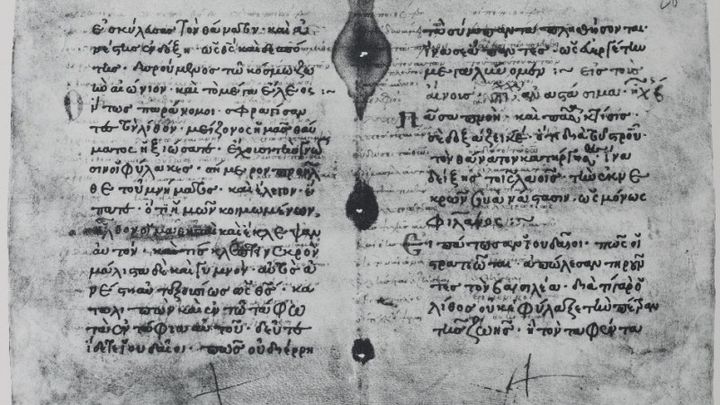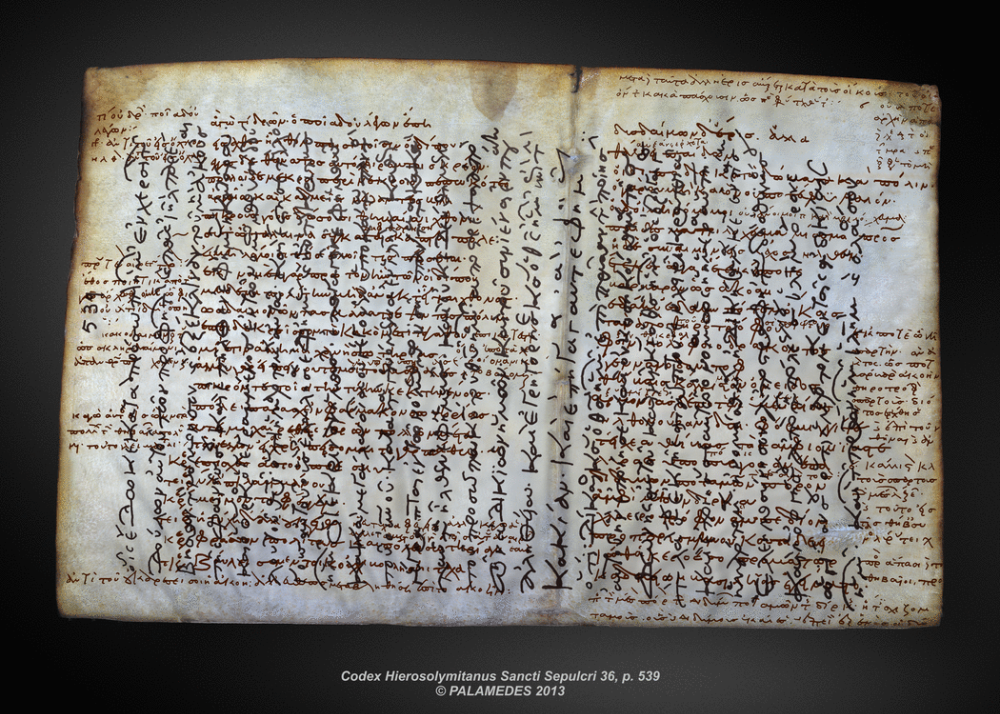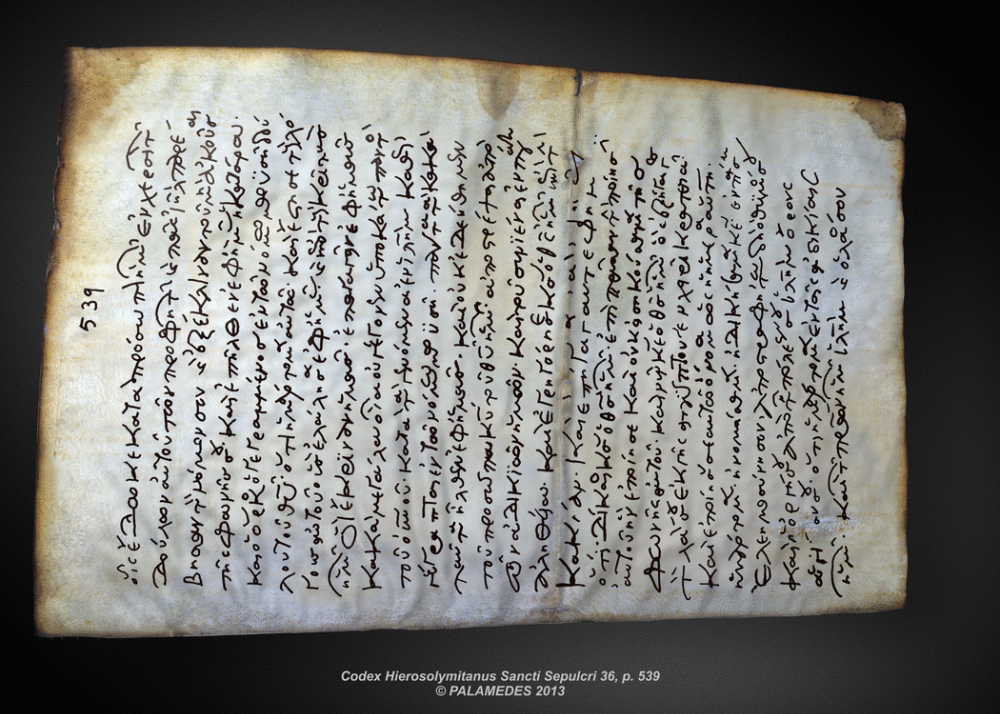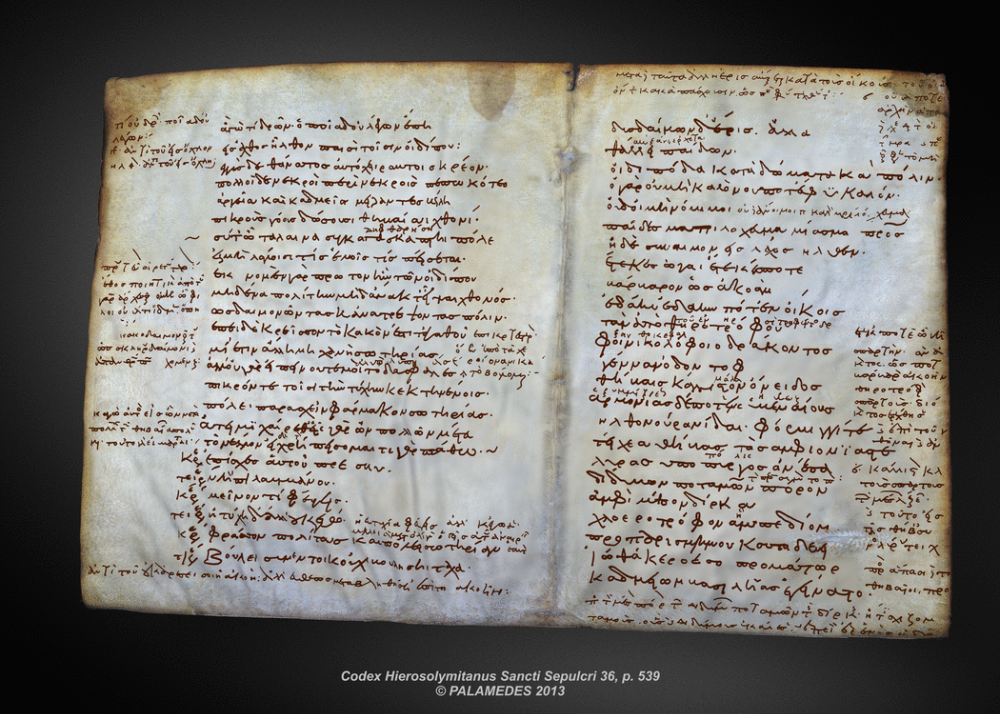
Milan Manuscript Project
Donation protected
The Hexapla Institute has the opportunity to produce a completely new edition of the Milan Manuscript (Ra. 1098), the largest currently known copy of Origen’s Hexapla, utilizing Three Dimensional Multi-Spectral Imaging Technology recently developed by Jonathan Albrecht.
Click here for a digitally enhanced demonstration of 3-D Multispectral Imaging Technology created by Jonathan Albrecht.
What is it?
Only four fragmentary copies of Origen’s work exist in Greek manuscripts: one contains a single verse, one contains the heading of the Psalter, one contains thirteen verses from Psalms, but Septuagint Manuscript 1098, located in the Biblioteca Ambrosiana in Milan, Italy, contains 148 verses from Psalms, along with a commentary in the margins.
The last photographic edition of the Milan Manuscript was produced in 1958 and is now out of print. This new technology will be especially advantageous for uncovering the contents of the Milan Manuscript because this manuscript is a palimpsest, a manuscript that was erased or scraped clean and reused. The original Hexaplaric Text of the Milan Manuscript was partially erased and another text was written over top. In the image above, one can see how remnants of the earlier writing are still visible, at times combining with the text written on top. The new imaging technology would allow one to completely separate the upper and lower text and view each independently.
How will the photos be made and used?
Jonathan and Felix Albrecht, in conjunction with SCHRIFT-BILDER and Scientific Media of Berlin, have agreed to produce the images for the Hexapla Institute for as little as $6,000. This money would cover the travel expenses for a three-day trip to Milan to make the new photographs, as well as the necessary digital post-processing.
Once complete, the images will be given to Professor Peter J. Gentry (Southern Baptist Theological Seminary), and he will supervise a doctoral dissertation in which the manuscript will be transcribed, its significance explained in light of current research, and the results published by Peeters Publishing, an international publishing house on the front lines of Septuagint scholarship.
Your contribution of any size would allow this work to move forward as soon as possible.
What is the Hexapla?
The Hexapla, produced by a Church Father named Origen, was a parallel Old Testament containing six editions:
– the Hebrew Text available to Origen around AD 250 (column 1)
– a representation in Greek letters of how to pronounce the Hebrew text (column 2)
– the earliest Greek translation of the Hebrew Old Testament commonly called the Septuagint (column 5)
– three other Jewish revisions of the Septuagint (Aquila, Symmachus, and Theodotion, columns 3, 4, and 6).
3-D Multi-Spectral Photography
The images below demonstrate how Three Dimensional Multi-Spectral Imaging Technology can enhance one’s ability to read the lower script as well as the over-writing of a palimpsest.
A palimpsest is a manuscript in which the original text has been scraped off and new writing placed over top.
The images below display the same pages of the same manuscript. This first image shows both layers of writing together.

The next two images show how this new technology allows one to completely isolate and view independently the writing above and below.


Click here for a digitally enhanced demonstration of 3-D Multispectral Imaging Technology created by Jonathan Albrecht.
A printable pamphlet can be accessed here.
Click here for a digitally enhanced demonstration of 3-D Multispectral Imaging Technology created by Jonathan Albrecht.
What is it?
Only four fragmentary copies of Origen’s work exist in Greek manuscripts: one contains a single verse, one contains the heading of the Psalter, one contains thirteen verses from Psalms, but Septuagint Manuscript 1098, located in the Biblioteca Ambrosiana in Milan, Italy, contains 148 verses from Psalms, along with a commentary in the margins.
The last photographic edition of the Milan Manuscript was produced in 1958 and is now out of print. This new technology will be especially advantageous for uncovering the contents of the Milan Manuscript because this manuscript is a palimpsest, a manuscript that was erased or scraped clean and reused. The original Hexaplaric Text of the Milan Manuscript was partially erased and another text was written over top. In the image above, one can see how remnants of the earlier writing are still visible, at times combining with the text written on top. The new imaging technology would allow one to completely separate the upper and lower text and view each independently.
How will the photos be made and used?
Jonathan and Felix Albrecht, in conjunction with SCHRIFT-BILDER and Scientific Media of Berlin, have agreed to produce the images for the Hexapla Institute for as little as $6,000. This money would cover the travel expenses for a three-day trip to Milan to make the new photographs, as well as the necessary digital post-processing.
Once complete, the images will be given to Professor Peter J. Gentry (Southern Baptist Theological Seminary), and he will supervise a doctoral dissertation in which the manuscript will be transcribed, its significance explained in light of current research, and the results published by Peeters Publishing, an international publishing house on the front lines of Septuagint scholarship.
Your contribution of any size would allow this work to move forward as soon as possible.
What is the Hexapla?
The Hexapla, produced by a Church Father named Origen, was a parallel Old Testament containing six editions:
– the Hebrew Text available to Origen around AD 250 (column 1)
– a representation in Greek letters of how to pronounce the Hebrew text (column 2)
– the earliest Greek translation of the Hebrew Old Testament commonly called the Septuagint (column 5)
– three other Jewish revisions of the Septuagint (Aquila, Symmachus, and Theodotion, columns 3, 4, and 6).
3-D Multi-Spectral Photography
The images below demonstrate how Three Dimensional Multi-Spectral Imaging Technology can enhance one’s ability to read the lower script as well as the over-writing of a palimpsest.
A palimpsest is a manuscript in which the original text has been scraped off and new writing placed over top.
The images below display the same pages of the same manuscript. This first image shows both layers of writing together.

The next two images show how this new technology allows one to completely isolate and view independently the writing above and below.


Click here for a digitally enhanced demonstration of 3-D Multispectral Imaging Technology created by Jonathan Albrecht.
A printable pamphlet can be accessed here.
Organizer
Brian Davidson
Organizer
Louisville, KY


